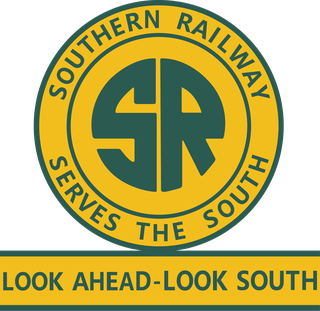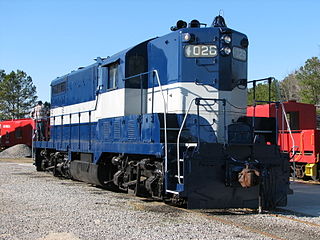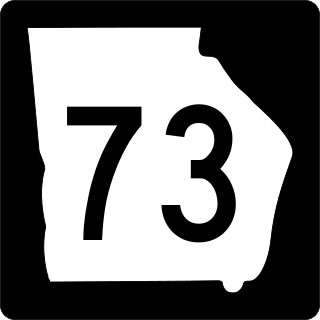Heritage unit
In 2012, the Norfolk Southern Railway painted EMD SD70ACe #1065 in the Savannah and Atlanta paint scheme as part of its 30th anniversary celebrations. [6]
The Savannah and Northwestern Railway was a railroad in the U.S. state of Georgia. From 1906 to 1914, it was named the Brinson Railway after its owner, George M. Brinson, a businessman who had earlier built the Stillmore Air Line Railway. The line was originally planned to run from Savannah to Sylvania and had completed from Savannah to Newington by 1909. Around this time the Brinson took over the Savannah Valley Railroad and merged its lines into the Brinson. The company's property was sold to the Savannah and Atlanta Railway on July 16, 1917. [1] [2]
The Savannah and Atlanta Railway operated a mixed passenger and freight train from Waynesboro to Savannah (using its own terminal at the latter) until 1959. [3] [4] [5]
In 2012, the Norfolk Southern Railway painted EMD SD70ACe #1065 in the Savannah and Atlanta paint scheme as part of its 30th anniversary celebrations. [6]

The Norfolk Southern Railway is a Class I freight railroad operating in the Eastern United States. Headquartered in Atlanta, the company was formed in 1982 with the merger of the Norfolk and Western Railway and Southern Railway. The company operates 19,420 route miles in 22 eastern states, the District of Columbia, and has rights in Canada over the Albany to Montréal route of the Canadian Pacific Railway. Norfolk Southern Railway is the leading subsidiary of the Norfolk Southern Corporation.

The Southern Railway was a class 1 railroad based in the Southern United States between 1894 and 1982, when it merged with the Norfolk and Western Railway (N&W) to form the Norfolk Southern Railway. The railroad was the product of nearly 150 predecessor lines that were combined, reorganized and recombined beginning in the 1830s, formally becoming the Southern Railway in 1894.

The Seaboard Air Line Railroad, which styled itself as "The Route of Courteous Service", was an American railroad which existed from April 14, 1900, until July 1, 1967, when it merged with the Atlantic Coast Line Railroad, its longtime rival, to form the Seaboard Coast Line Railroad. Predecessor railroads dated from the 1830s and reorganized extensively to rebuild after the American Civil War. The company was headquartered in Norfolk, Virginia, until 1958, when its main offices were relocated to Richmond, Virginia. The Seaboard Air Line Railway Building in Norfolk's historic Freemason District still stands and has been converted into apartments.

The Atlantic Coast Line Railroad was a United States Class I railroad formed in 1900, though predecessor railroads had used the ACL brand since 1871. In 1967, it merged with long-time rival Seaboard Air Line Railroad to form the Seaboard Coast Line Railroad. Much of the original ACL network has been part of CSX Transportation since 1986.

The Georgia Railroad and Banking Company also seen as "GARR", was a historic railroad and banking company that operated in the U.S. state of Georgia. In 1967 it reported 833 million revenue-ton-miles of freight and 3 million passenger-miles; at the end of the year it operated 331 miles (533 km) of road and 510 miles (820 km) of track.

The Central of Georgia Railway started as the Central Rail Road and Canal Company in 1833. As a way to better attract investment capital, the railroad changed its name to Central Rail Road and Banking Company of Georgia. This railroad was constructed to join the Macon and Western Railroad at Macon, Georgia, in the United States, and run to Savannah. This created a rail link from Chattanooga, on the Tennessee River, to seaports on the Atlantic Ocean. It took from 1837 to 1843 to build the railroad from Savannah to the eastern bank of the Ocmulgee River at Macon; a bridge into the city was not built until 1851.

The Norfolk Southern Railway was the final name of a railroad that ran from Norfolk, Virginia, southwest and west to Charlotte, North Carolina. It was acquired by the Southern Railway in 1974, which merged with the Norfolk and Western Railway in 1982 to form the current Norfolk Southern Railway.

The Atlanta, Birmingham and Coast Railroad was organized in 1926 to replace the bankrupt Atlanta, Birmingham and Atlantic Railway. The AB&C was controlled by the Atlantic Coast Line Railroad, which owned a majority of the stock. In 1944 it reported 763 million net ton-miles of revenue freight and 33 million passenger-miles; at the end of that year it operated 639 miles of road and 836 miles of track.
The West Point Route was actually a nickname used in the early 20th century for the joint operations of the Atlanta and West Point Railroad and the Western Railway of Alabama. The name refers to the city of West Point, Georgia, where the two railroads met.

Southern Railway 4501 is a preserved Ms class 2-8-2 "Mikado" type steam locomotive built in October 1911 by the Baldwin Locomotive Works in Philadelphia, Pennsylvania as the first of its wheel arrangement type for the Southern Railway (SOU). In 1948, the locomotive was retired from the SOU in favor of dieselization and was sold to the shortline Kentucky and Tennessee Railway (K&T) in Stearns, Kentucky to haul coal trains.

State Route 26 (SR 26) is a 271.1-mile-long (436.3 km) state highway that travels west-to-east through portions of Chattahoochee, Marion, Schley, Macon, Houston, Pulaski, Bleckley, Laurens, Johnson, Emanuel, Bulloch, Bryan, Effingham, and Chatham counties through the central part of the U.S. state of Georgia. It crosses nearly the entire width of the state, connecting Cusseta, on the southeastern edge of Fort Benning, near Columbus to Tybee Island on the Atlantic coast near Savannah, via Buena Vista, Ellaville, Oglethorpe, Hawkinsville, Cochran, Dublin, Swainsboro, Statesboro, and Savannah.
The Georgia Rail Passenger Program (GRPP) was a set of plans, as yet unbuilt, for intercity and commuter rail in the U.S. state of Georgia.
The transportation system of Georgia is a cooperation of complex systems of infrastructure comprising over 1,200 miles (1,900 km) of interstates and more than 120 airports and airbases serving a regional population of 59,425 people.

The Southeastern Railway Museum is a railroad museum located in Duluth, Georgia, in suburban Atlanta.

State Route 73 (SR 73) is a 78.1-mile-long (125.7 km) state highway in the eastern part of the U.S. state of Georgia. It connects Glennville with the South Carolina state line, via Claxton, Statesboro, Dover, and Sylvania. Except for a brief portion in the Sylvania area, it is completely concurrent with U.S. Route 301 (US 301). Its southern terminus is at US 25/US 301/SR 23/SR 57 and SR 144 in Glennville. Its northern terminus is at the South Carolina state line, east of Millhaven, where US 301 enters that state.
The New York, Philadelphia and Norfolk Railroad was a railroad line that ran down the spine of the Delmarva Peninsula from Delmar, Maryland to Cape Charles, Virginia and then by ferry to Norfolk, Virginia. It became part of the Pennsylvania Railroad system.

Terminal Station, Macon, Georgia, is a railroad station that was built in 1916, and is located on 5th St. at the end of Cherry St. It was designed in the Beaux-Arts style by architect Alfred T. Fellheimer (1875–1959), prominent for his design of Grand Central Terminal in New York City in 1903. The station building is part of the Macon Historic District, which is listed on the National Register of Historic Places. While no longer an active train station, it has been the location of the Macon Transit Authority bus hub since 2014.
Augusta Union Station was a train depot in Augusta, Georgia at 525 8th Street, serving trains from its opening in 1903 to its closing in 1968. The Spanish Renaissance styled building was in central Augusta at Barrett Square, five blocks from the banks of the Savannah River.

Columbus Union Station was a union station in Columbus, Georgia. The building was built in 1901 and was designed in the Second Empire style by the architectural firm, Bruce and Morgan. The station hosted the Central Railroad of Georgia, the Seaboard Air Line Railroad and the Southern Railway. It was located at 1200 Sixth Avenue, directly north of 12th Street, Columbus.